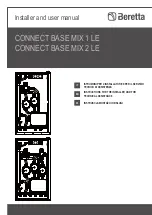
Remeha Quinta 30
8
2.2 Operating principle
Combustion air is drawn into the closed air box by a variable speed fan, through the
air inlet connection from the plant room (open flued) or from outside via the concentric
flue system (room sealed). On the inlet side of the fan is a specially designed venturi
which is connected to the outlet side of the gas combi block.
Depending on the demand (under the dictates of flow/return sensor and other external/
internal control inputs) the electronic control unit directly monitors the volume of gas
and air being delivered to the premix burner. This mixture is initially ignited by the
combined ignition/ionisation probe which then monitors the state of the flame. Should
the flame not ignite or is unstable within the pre-set safety time cycle the controls will
shut the boiler down (after 5 attempts) requiring manual intervention to reset the boiler.
The digital display will also indicate a flashing fault code confirming the reason for the
failure.
The products of combustion in the form of hot flue gases are forced through the heat
exchanger transfering their heat to the system water (the flue gas temperature is
reduced to approximately 5°C above the temperature of the system return water) then
discharged via the condensate collector, vertically through the 80/125 mm combined
flue/air connection to atmosphere.
Because of the low flue gas exit temperature there will be a vapour cloud formed at
the flue gas terminal - this is not smoke, simply water vapour formed during the com-
bustion process.
If the controls allow the flow and therefore return temperature to fall below dew point
(55°C) this water vapour will begin to condense out in the boiler, transfering it’s latent
heat into the system water, increasing the output of the boiler without increasing the
gas consumption.
Condensation formed within the boiler and flue system is discharged from the boiler to
an external drain via the drain pan / siphon supplied.
57117.indd 8
57117.indd 8
1-4-2009 14:35:49
1-4-2009 14:35:49









































